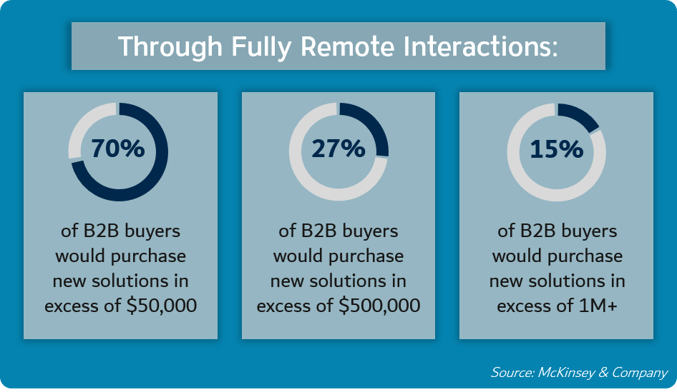
Remote Selling is Here to Stay: 3 Ways to Drive Numbers Up
Categories: Sales Messaging | Sales Process
Remote selling, buying, prospecting and training is here to stay. Even as lockdowns and restrictions loosen, B2B buyers continue to embrace, but also seem to prefer, remote interactions over face-to face meetings. That’s according to new research just published by McKinsey. At Force, we’ve found similar trends. Elite sales leaders are analyzing how well they’re supporting their salespeople in the remote environment, and making strategic changes to drive continued success or improve numbers.
The Future of B2B Sales & What Sales Leaders Are Doing:
A majority of B2B buyers and sellers continue to prefer remote selling, including those who regularly work to purchase and close high-value contracts. According to the recent McKinsey study, more than 75% of buyers and sellers prefer virtual interactions. Through these fully remote interactions:
- 70% of B2B buyers would purchase new solutions in excess of $50,000
- 27% of B2B buyers would purchase new solutions in excess of $500,000
- 15% of B2B buyers would purchase new solutions in excess of 1M+
We’ve seen this preference for remote selling cause sales leaders to focus on significantly improving sales effectiveness in the virtual environment. Rather than continue to run on a shifted process developed mid-crisis, sales leaders are implementing strategic sales initiatives to fix gaps, achieve alignment with their buyers and improve rep execution. These are three initiatives sales leaders are prioritizing:
1. Launching a buyer-focused sales message
In the virtual environment, cracking into new opportunities and digging deeper into territories has been an on-going challenge. According to the McKinsey study, buyer budgets are opening up and they’re prioritizing OPEX and CAPEX investments to improve their company’s ability to compete in 2021. More and more companies are reaching their turnaround point, the article notes “a significant amount of B2B decision makers are expecting their CAPEX and OPEX budgets to rise.”
We know when sellers present their buyers with a relevant business case and help the buyer come to the conclusion that they have an urgent, pressing business problem that needs to be fixed, the velocity of the deal picks up dramatically.
Many of our customers are focused on improving their sales organization’s ability to compete and leverage expanding buyer budgets. To help them drive numbers up, we’ve recommended sales leaders ensure their sales message aligns to their buyer’s biggest business problems, desired outcomes and ROI solution requirements. They’re launching virtual sales messaging initiatives and already seeing immediate improvements to quota attainment and margins.
Consider four reasons why sales organizations are launching sales messaging transformations before year-end or early next year.
2. Optimizing the sales process, by generating alignment with the buyer
The McKinsey study emphasizes how alignment with the buyer is critical right now. The authors mention “customers are demanding remote interactions stick long term and they are rewarding suppliers that do it well”.
When the sales process is effectively aligned to the way your ideal buyers want to buy, salespeople are better equipped to capture, qualify and close high-value deals efficiently. This alignment also helps salespeople ensure they’re working on the highest value opportunities and building relationships that lead to long-term contracts, cross-sells and up-sells.
Given the current state, many of our customers have found that their ideal buyers may have changed or their buying market may have expanded, due to new acquisitions, new products and new trends. Because of these shifts, optimizing the sales process to better align with the buyer is a huge opportunity for sales leaders right now. Ensuring you can do it in remotely will be critical and may be the one thing that separates the best solution providers from the rest.
While this opportunity is significant, so too is the pressure to do it right. Developing cross-functional C-suite alignment on your ideal buyer and their buying process will help define what’s missing in your sales process and qualification criteria. From there, you can define where to implement key changes to course correct.
Qualification methodologies, like MEDDICC or it's variants, can be used to support your salespeople in doing their due diligence and understanding the key components that impact the buying decision (e.g. metrics, decision process, identification of business pains, competition). Customizing the qualification criteria to your organization and ideal buyer will enable your sales organization to ensure that the way they sell is aligned with the way your customers want to buy. If you’ve identified gaps in your sales and qualification process, see how you can use MEDDICC to qualify better and improve your team’s ability to drive alignment with their buyers and focus on the highest-value opportunities.
3. Implementing a Management Operating Rhythm (MOR)
According to the McKinsey article, “B2B sales leaders have moved from being ‘forced’ to adopt digital in reaction to the widespread shutdowns in the early stages of COVID-19 to a growing conviction that digital is the way to go.”
With that being said, we continue to recommend to our customers that, no matter what area of sales effectiveness they’re working to improve right now — your front-line managers will be key to driving high-value results in the virtual environment.
Your front-line managers are working daily to keep their reps focused on the buyer and productive in this virtual and uncertain environment. If they’re operating on a silo, without support or knowledge beyond what their reps are hearing in the field, their numbers will only reflect their best guess at how to support their sales teams. The sales leaders who find ways to enable their managers to drive accountability and coach reps to success will see the most immediate up-ticks to numbers and market share.
Improve their ability to coach repeatable, high-value skills and drive accountability by providing a management operating rhythm or coaching cadence that goes beyond quick monthly check ins. Regardless of current state, a great sales operating rhythm or MOR creates a cadence around the critical management activities that have the greatest impact on the bottom line. When executed effectively, an MOR gives managers a consistent way to provide their reps with clear direction on high-value sales activities and how to execute on them.
Beyond the MOR, ensure your front- and second-line managers establish a plan of attack for what good looks like in the virtual environment and how they can best support their sales teams in performing high-value sales activities that drive results.
Moving Forward With Sales Initiatives that Support Long-Term Success
The McKinsey article concludes by noting, “The future is digital—and optimistic”.
Launching a sales initiative in the virtual environment has become a powerful way for sales organizations to achieve immediate results, improvement in execution, and ensure ROI from the engagement. They’re benefiting from early action, regardless of external factors.
The longer you wait to launch your strategic initiative, the longer it will take to achieve your desired outcomes. See how we’re supporting customers propel their sales organization forward through sales transformation engagements, launched in the virtual environment.



